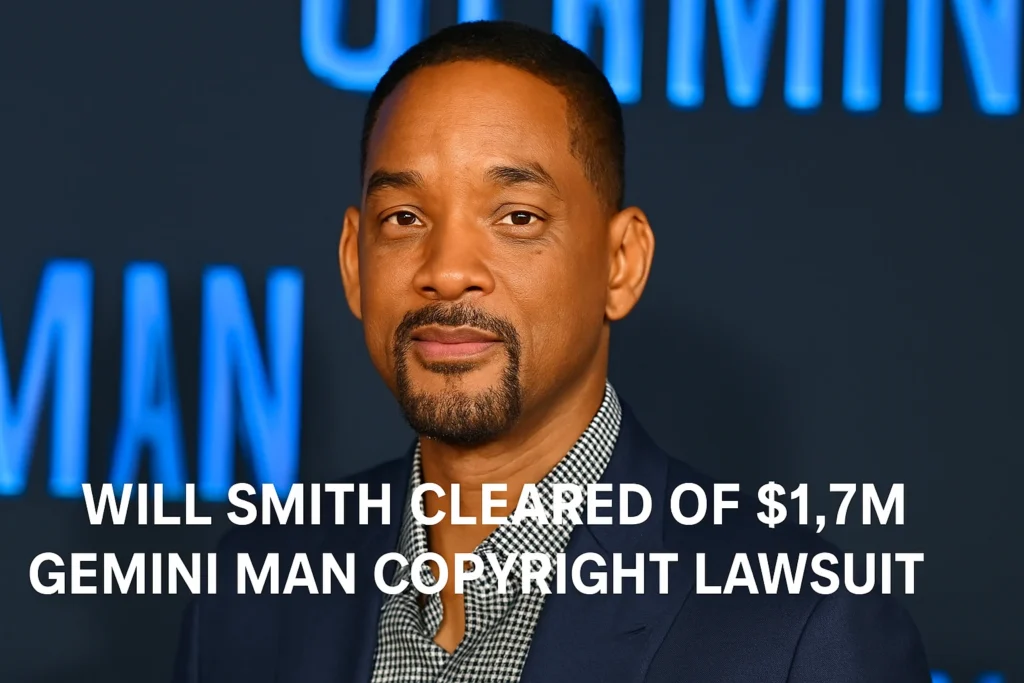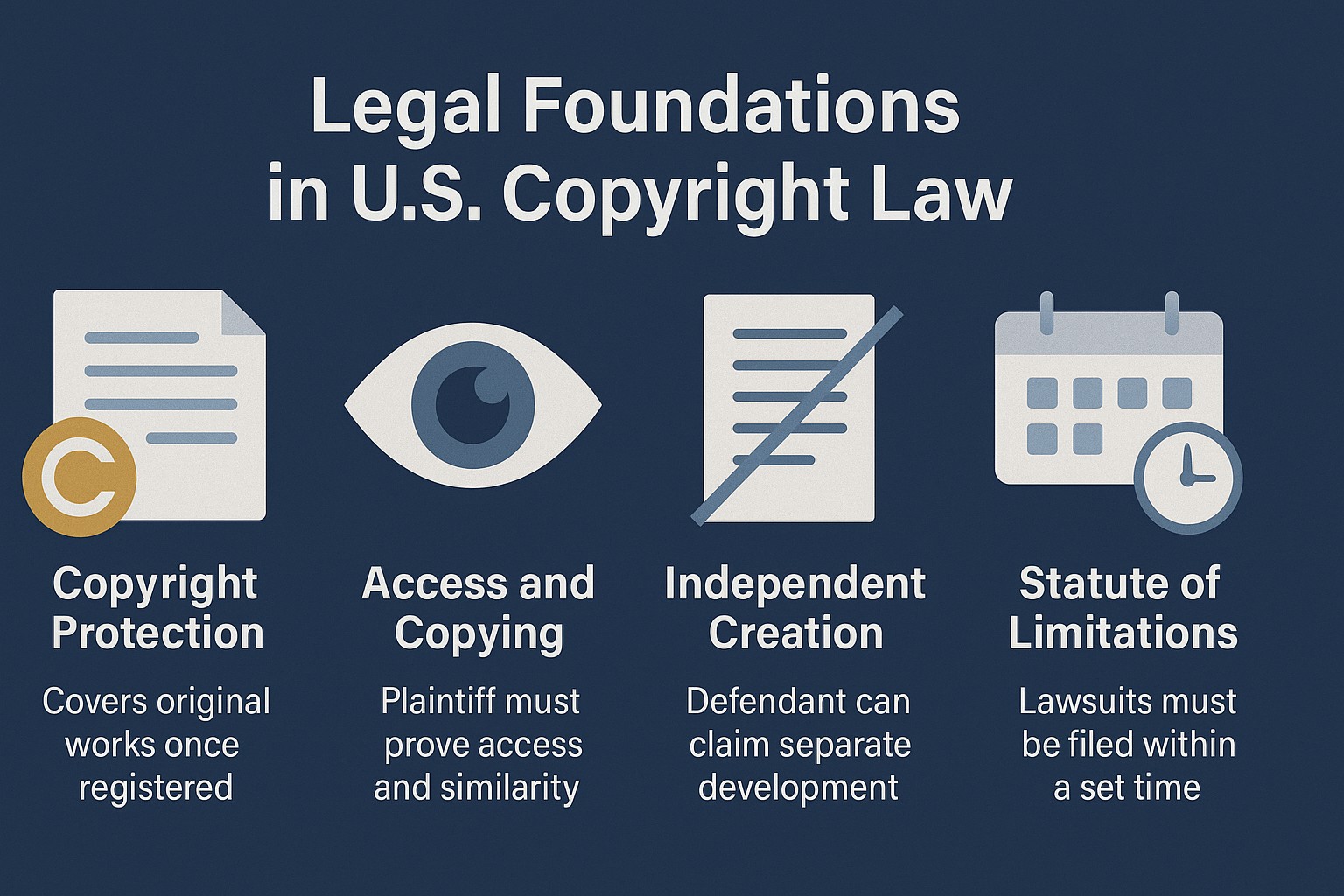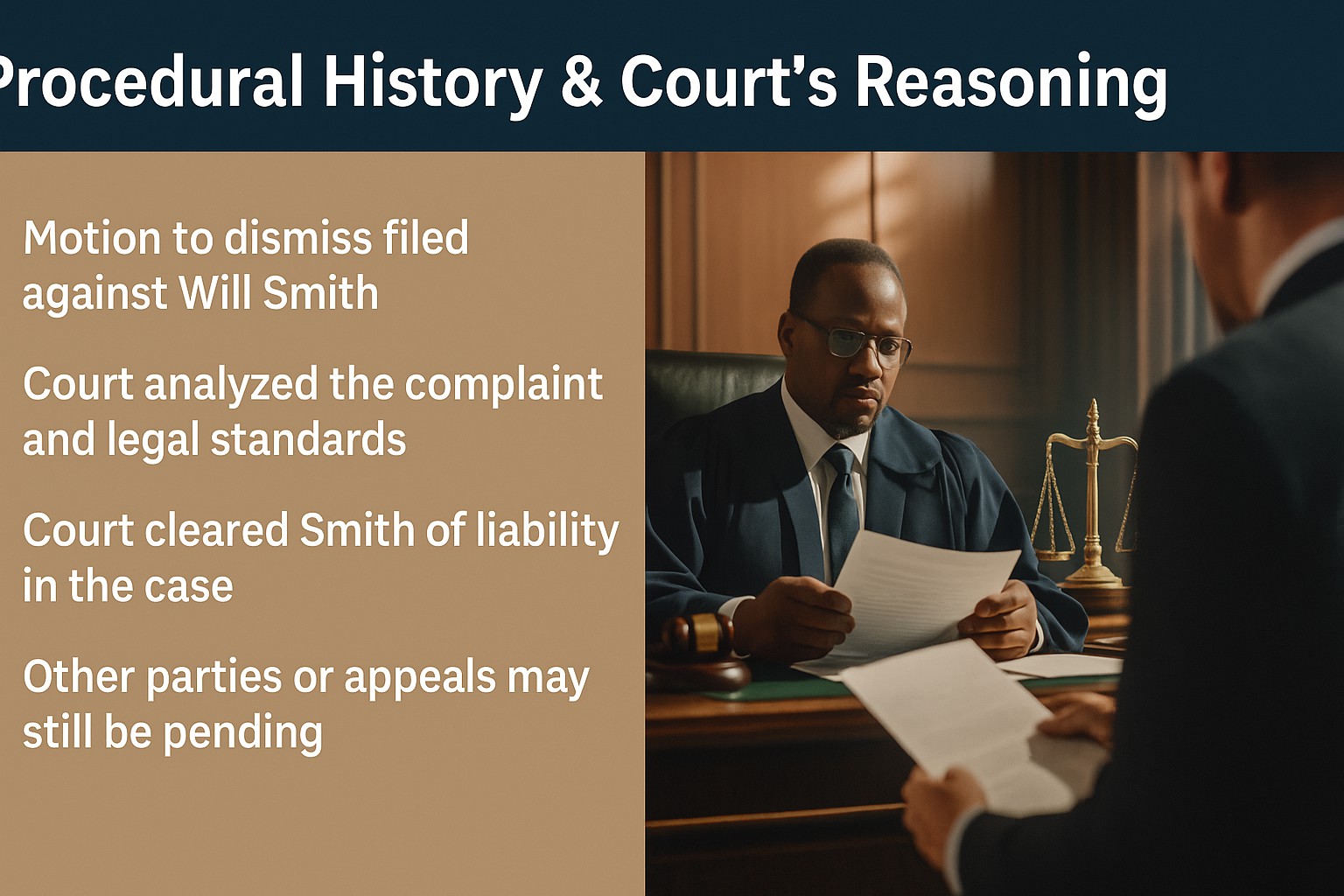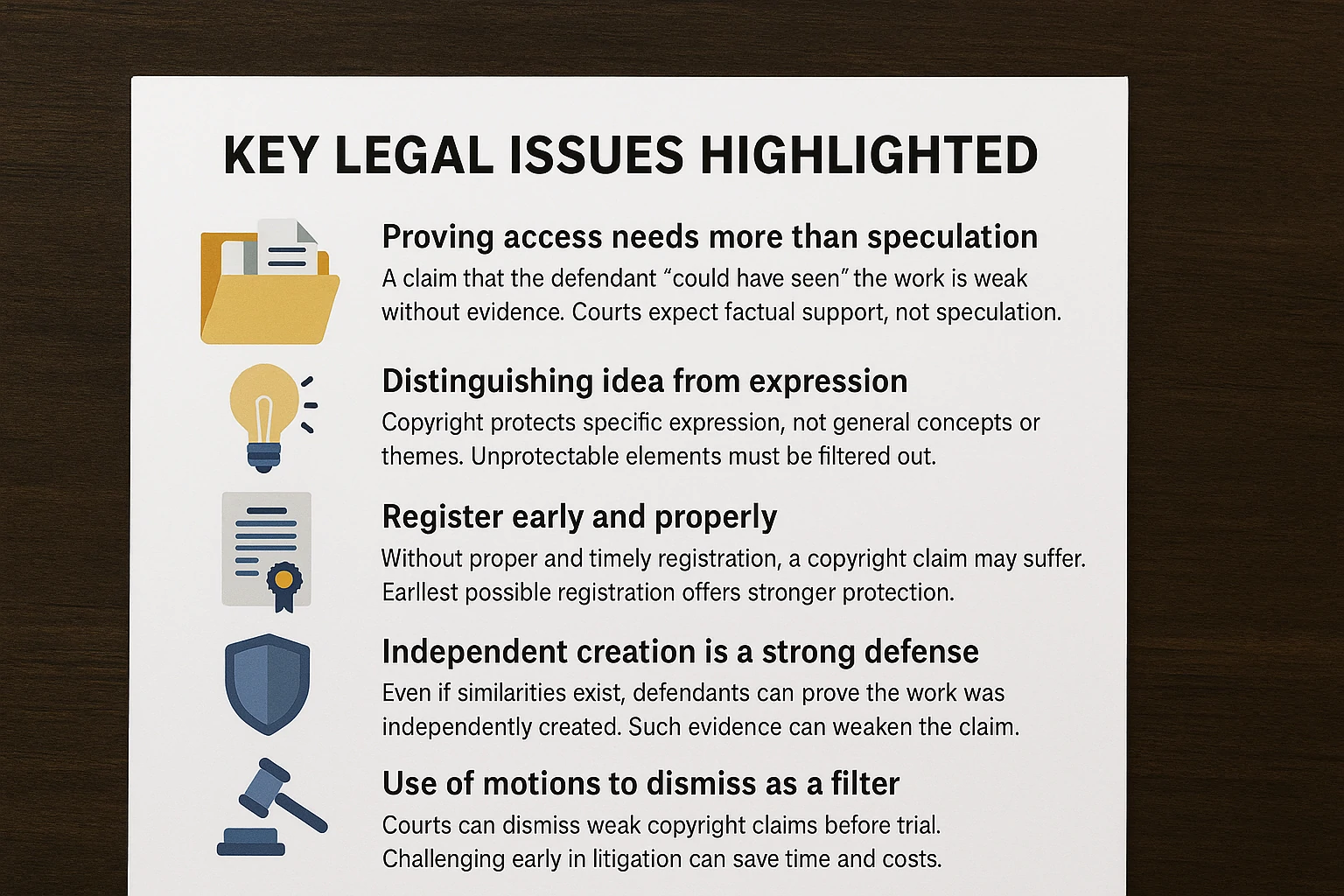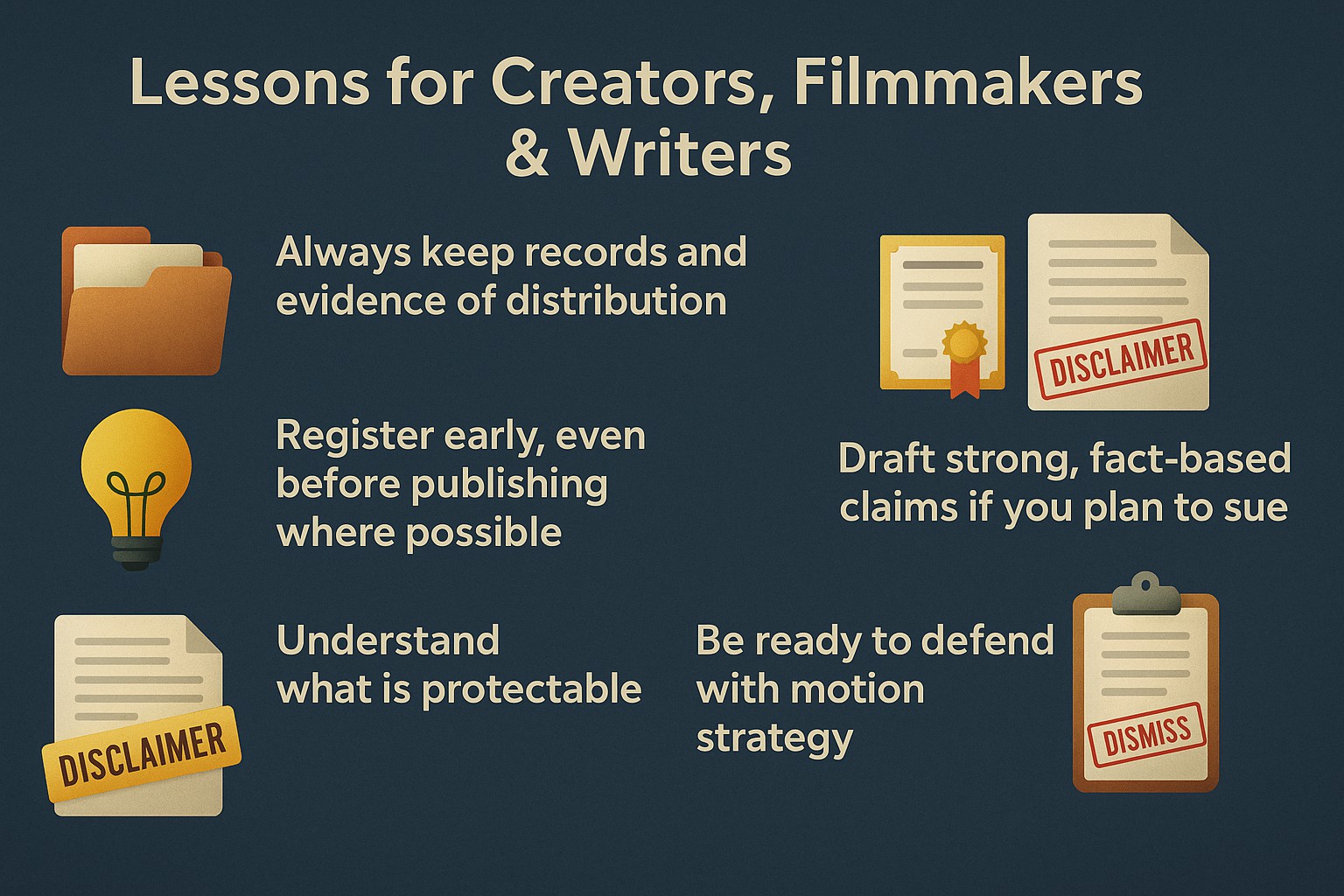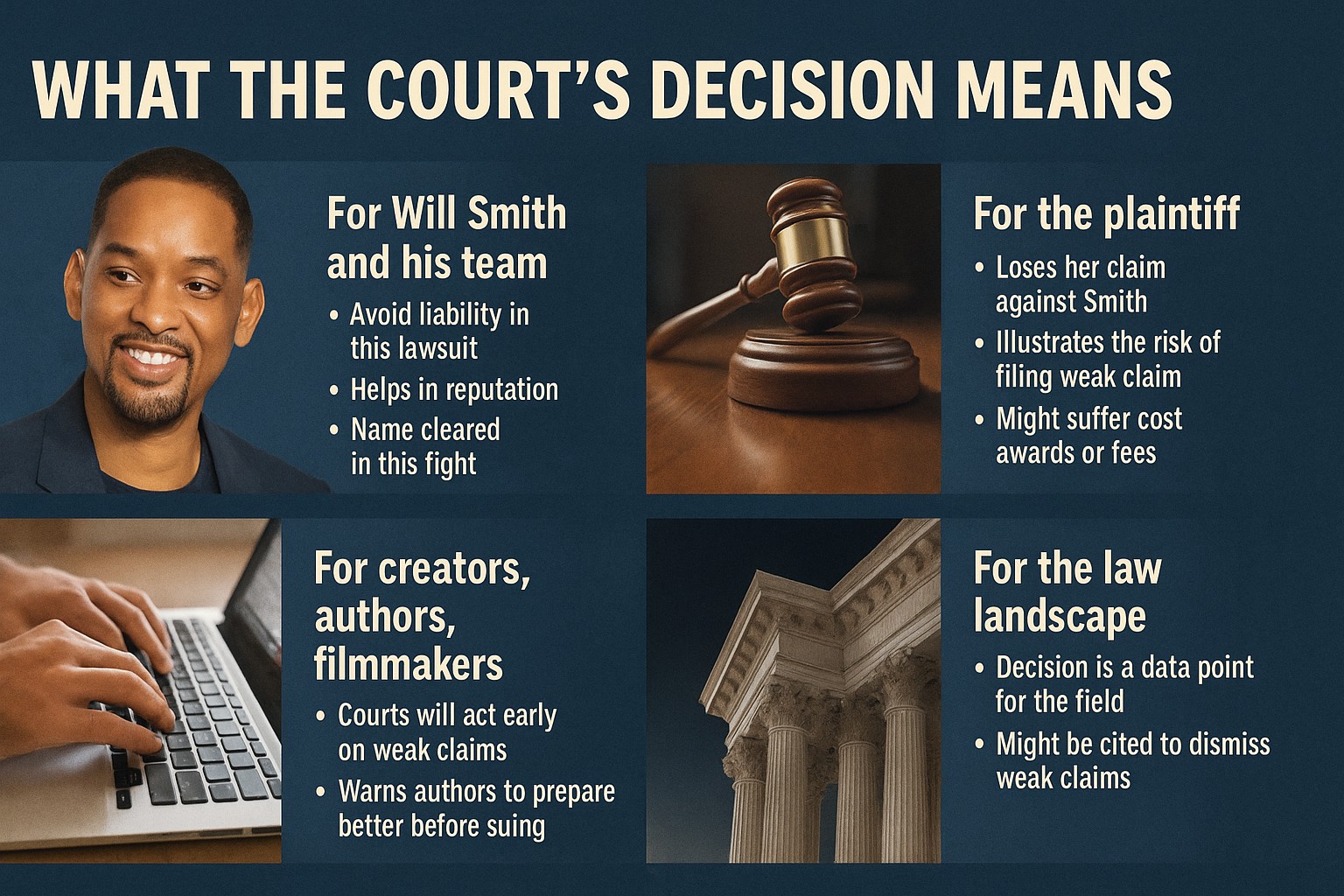The news that Will Smith was cleared in the $1.7 million Gemini Man copyright lawsuit grabbed attention. Many wondered how a high‑stakes claim ended without him being held liable. This case touches on key issues in copyright law. It also holds lessons for writers, filmmakers, and creators.
In this article you will see the full story. You will get a clear legal breakdown of how Smith was cleared. You will also learn what it means for creators and what to watch in future cases.
I will avoid legal jargon and i use plain English so anyone can follow. I explain each step, each ruling, and each lesson. This is your guide to understand what happened and why it matters.
Let us begin by reviewing the background of the case.
Background: The Gemini Man Copyright Claim
In the lawsuit, an author claimed that Gemini Man borrowed heavily from her work. She asked for $1.7 million in damages. She named Will Smith among the defendants. The claim alleged that certain story elements, characters, or ideas matched her prior writing.
She argued that Gemini Man copied her work without permission. The suit claimed that she had registered her work and that there was access, meaning the filmmakers could have seen her work. The complaint asserted “substantial similarity” in many parts.
The defendants (including Will Smith) denied the claims. They argued that the similarities were general ideas or themes-not protectable expression, They also claimed independent creation and they moved to dismiss the suit against Smith.
A court reviewed the motion, the complaint, and prior law in copyright. In the end, the judge granted the motion in favor of Smith. That means the court cleared him of liability in that suit.
Next, I will explain the legal grounds used, the court’s reasoning, and key rulings.
How to Start a Class Action Lawsuit and Protect Your Rights the Smart Way
Legal Foundations in U.S. Copyright Law
To grasp how Smith was cleared, you need to understand certain copyright rules. These rules shape how courts decide such cases.
Copyright protection and registration
Copyright law protects original expression, not mere ideas, facts, or themes. You cannot copyright a general plot idea. You can copyright how the plot unfolds, character dialogue, specific scenes, and structure.
In the U.S., you usually must register your work with the U.S. Copyright Office before suing for infringement (or at least before certain deadlines). Without registration, some claims may fail.
If the plaintiff did not properly register or did so too late, courts may refuse to allow damages or even dismiss parts of the case.
Access and copying
To succeed, a plaintiff must show that the defendant had access to the prior work (i.e. opportunity to see it) and that there is substantial similarity between the protected parts of the works. Access can come via the author sharing the work, public circulation, or industry exposure.
Substantial similarity means that an ordinary observer would see that the works share protected expression-not just ideas. If similarities are only in unprotectable elements (ideas, themes, genres), the claim fails.
Independent creation and fair use
Defendants can argue that they independently created their work. That is, they never saw or used the plaintiff’s work. Even if two works resemble each other, independent creation is a valid defense.
Fair use is another defense. But fair use normally applies in limited contexts (criticism, commentary, parody, etc.). In a big feature film context, fair use is harder to claim for major narrative borrowing.
Statute of limitations and prior dismissal
The plaintiff must file the case within a time limit (statute of limitations). If she missed that window, the court may bar claims. Also, if she filed an earlier suit or a similar claim and got dismissed, the doctrine of res judicata or claim preclusion might bar relitigation.
With these rules in mind, we can see how the court applied them in Gemini Man.
Procedural History & Court’s Reasoning
This section walks you step by step through the case process and the court’s key rulings about Smith.
Motion to dismiss
Defendants moved to dismiss the complaint against Smith. A motion to dismiss tests whether the complaint, on its face, states a valid legal claim. The court asks: even assuming the facts in the complaint are true, do they suffice under law?
The court looked at the complaint’s allegations about access, similarity, registration, and alleged copying and the court also examined prior cases and used legal precedents.
Why claims against Will Smith were dismissed
First, the court found that the plaintiff did not establish access to her work by Smith or his team in a plausible way. The complaint lacked concrete facts (no emails, no distribution record, no proof of industry exposure) that would show Smith’s team saw her work.
Second, the court saw that many of the claimed similarities fell into unprotectable territory – ideas, general themes, or scenes that are common in the genre. The complaint did not isolate the expressive elements that allegedly matched.
Third, the court found that some claims lacked proper copyright registration at the right time. In some parts, the plaintiff might have registered too late or not at all, which weakened her entitlement to relief.
Fourth, the court said that even accepting the complaint’s claims, the differences between the works were substantial. The court held that lay observers would not see the works as substantially the same in the protected parts.
Because of those failures, the court granted the motion to dismiss as to Will Smith. In other words, the court cleared him of liability in that claim.
What remains for other defendants or appeals
The dismissal did not necessarily resolve the case as a whole. The suit may continue against other parties (writers, producers, studios). The plaintiff might refile or appeal. Some claims might survive.
If the plaintiff appeals, she might try to amend the complaint, add facts, or argue different legal theories. The court’s decision might be reversed or modified. But at this level, Smith is no longer a target in this suit.
Key Legal Issues Highlighted
In Smith’s dismissal, the case raised several legal issues worth noting. These serve as lessons for creators and anyone facing or filing copyright claims.
Proving access needs more than speculation
A claim that the defendant “could have seen” the work is weak without evidence. A stronger case arises when one can show actual distribution, copies sent, emails, or industry contact. Courts expect factual support, not bare assumptions.
In this case, the plaintiff offered little in the way of specific proof that anyone in Smith’s orbit saw her work. That lack of specific facts doomed her claim.
Distinguishing idea from expression
Many litigation fails because plaintiffs confuse ideas with expression. Two stories can share a concept (e.g. “man fights his clone”) without copying protectable expression.
Sensitive drafting is needed to compare the exact expression (scenes, dialogue, structure), not just theme or trope. Courts will strip away unprotectable elements before comparing.
Register early and properly
Registration timing matters. If you wait too long to register, some claims or relief may be lost. Registering before or soon after publication supports your claim and your access to certain remedies.
In Smith’s case, part of the complaint lacked adequate registration support. This undermined her claim.
Independent creation is a strong defense
Even when similarities exist, a defendant can claim they never saw the work. If they can show a path of independent development, that can defeat the claim.
Here, Smith’s defense (and likely the studio’s) argued independent creation was plausible. The court accepted that possibility where plaintiff did not show the opposite.
Use of motions to dismiss as a filter
A well drafted motion to dismiss can bar weak cases early. Courts use them to weed out claims lacking factual support. The earlier you challenge the complaint, the more you can avoid discovery costs. Smith’s motion succeeded because the complaint lacked detail.
Lessons for Creators, Filmmakers & Writers
The Smith case offers several practical lessons. Whether you write novels, short stories, film scripts, or screenplays – you can learn from it.
Always keep records and evidence of distribution
If you submit work (to agents, studios, producers), keep proof: dates, names, emails, receipt confirmations. You want a paper trail showing where your work went.
That trail can help prove access in case of dispute. Without it, your claim may rest on speculation, which courts reject.
Register early, even before publishing where possible
Register your work early. In the U.S., registration gives you stronger legal footing. When the law requires registration, don’t delay.
If multiple versions exist (draft, published, revised), consider registering each form if they differ. That may help in future claims.
Understand what is protectable
Learn the difference between ideas, themes, and expression. Only expression is protected (dialogue, plot structure, character details). Develop work with originality in these areas.
Avoid copying structure or scenes from prior works too closely. When you refer to tropes or common ideas, add original detail.
Use disclaimers & get legal advice in adaptations
If you adapt or base a work loosely on someone else’s idea, consider a disclaimer or seek legal counsel. Work with attorneys to assess risk and possible permissions.
In collaborations, define ownership, rights, and clearances in contracts before production begins. That helps prevent disputes.
Draft strong, fact‑based claims if you plan to sue
If you believe someone copied your work, do not launch a vague complaint. Build your case: show access (distribution, emails), highlight specific matching expressive elements, show registration, and differentiate your work.
A lawsuit based on generic or speculative claims will likely be dismissed early-as the plaintiff learned in this case.
Be ready to defend with motion strategy
As a defendant, consider using a motion to dismiss early. Challenge weak claims on their face. That can save time and cost.
If you represent creators, teach them to test infringement claims before investing in full litigation.
This case shows how weak complaints can be dismissed early. You can also explore how Georgia law handles settlement offers and fee shifts in lawsuits in this OCGA 9-11-68 Guide.
What the Court’s Decision Means
Let us look at the implications of clearing Smith and what parties and creators should watch.
For Will Smith and his team
They avoid liability in this lawsuit. They will not owe damages or legal costs under this claim. Their name is cleared in this legal fight (at this stage).
It helps in reputation: the court found the claims too weak to proceed against him.
For the plaintiff
She loses her claim against Smith. She may lose the ability to collect on that portion and she may appeal or refile against other parties. But her case against Smith is gone (unless reversed).
Her failure illustrates the risk of filing a weak claim. She might also suffer cost awards or fees (depending on local rules).
For other defendants and ongoing litigation
Other defendants remain in the case. The plaintiff may face similar arguments and motions. She may adjust her complaint, add facts, or strengthen her theories.
Defendants will watch whether the court extends this reasoning to them. Similar motions may be filed.
For creators, authors, filmmakers
This case sets a reminder: courts will act early to dismiss weak claims. It warns authors to prepare better before suing and It also warns creators to guard their work, document submissions, and register early.
It may influence future copyright cases, courts may require plaintiffs to do more upfront work before launching suits.
For the law landscape
This decision is a data point in a field where many disputes hinge on motion practice. It may be cited in other cases as precedent for dismissing weak claims or for showing demand for factual specificity.
If appellate courts affirm it, it might tighten what complaint drafting needs in similar litigations.
What to Watch Next
The lawsuit may not be over. Even though the court cleared Will Smith, the case still holds open threads. The plaintiff might respond in new ways. The next steps could shape how future lawsuits unfold in the film world.
She may choose to appeal. If she does, the court will review the ruling. The appeal might test how far copyright claims can go. Judges will decide if the first court made an error or missed something in law or fact.
Another option is a revised complaint. The plaintiff might try to add more facts. She could include new emails, timeline proof, or content comparisons. A stronger complaint may change how the court reacts next time.
Other defendants remain in the lawsuit. They might still face court decisions. Producers, writers, or the studio could become the next focus. If claims against them fail too, the court will show a clear pattern in how it sees such disputes.
This case may also affect how similar lawsuits play out. Other films with related plots or themes could see new legal action. Courts might use this case as a guide when facing future claims about script copying or idea theft.
Appellate courts or even the U.S. Supreme Court could weigh in. If higher courts review the matter, they may set a new rule or raise the bar for what counts as a strong copyright lawsuit. That would shape the future of creative law across the country.
Stay alert. This case is not just about one movie. It touches all who create, write, or produce stories. Each move in court tells us something about how the law protects work-and when it does not.
Full Legal Breakdown: What You Need to Know
A copyright lawsuit targeted Will Smith over the film Gemini Man. The woman who filed the suit said the movie took key parts from her earlier work. She claimed the theft caused real harm and asked the court for $1.7 million. Her legal papers named Will Smith as one of the main people responsible.
Smith’s lawyers took quick action. They filed a motion to dismiss the case. This motion asked the judge to end the lawsuit before trial. Their argument was clear. They said the complaint lacked facts and did not meet the rules of copyright law. They told the court there was no real link between Smith and the work in question.
The judge reviewed the case closely. The court checked if the facts in the complaint could support a legal claim. Each part of the lawsuit faced review. The judge looked at whether the case had enough legal weight to move forward.
After that review, the judge made a decision. The court dismissed the case against Will Smith. The ruling said the plaintiff failed to prove access. That means she could not show that Smith or his team had seen her work. The judge also said that the content in question did not show strong enough similarity. Most of the shared ideas were broad and common in action films.
There was another key issue. The plaintiff had not registered her work in the right way. Some parts of her material lacked valid copyright registration. That weakened her case. It also blocked her from asking for damages under federal law.
The decision removed Smith from the lawsuit. He will not face court over this matter. He has no further role in this case. However, the legal fight may not be over. The plaintiff may go after other people tied to the film. She might revise her lawsuit or appeal the ruling. Her options remain open, but Will Smith is no longer part of the case.
This ruling speaks loudly to writers and filmmakers. If you want to claim copyright theft, you need proof. Courts do not let weak cases move forward. Judges expect clear facts, valid legal points, and proper filing.
Writers must know what copyright covers. The law protects how a story is told. It guards the words, the scenes, the characters, and the structure. It does not cover broad ideas. A film about clones is not unique. Many stories share that theme. You must prove someone copied your exact work-not just your idea.
Creators must also act early. You need to register your work before a dispute starts. That simple act can make or break your case. Without it, you may lose your chance to claim damages.
Access is another key point. You must show the other side had a way to see your work. That means proof. You need emails, shared drafts, or trusted witnesses. Guesswork does not hold up in court.
Anyone planning to sue should get ready first. Gather your facts. Build your case. Show how your work reached the people you accuse. If you do not have that, your case will fall apart.
This case is one of many that ended fast. It reminds everyone that strong claims need strong facts. It shows how copyright law protects real content, not just broad ideas. And it proves that even high-profile cases need to follow the rules.
Conclusion
Will Smith’s clearing of the $1.7M Gemini Man copyright lawsuit is more than a celebrity legal drama. It is a case study in how courts treat copyright claims. The decision shows that courts demand careful pleading, factual support, and sound legal theory.
Creators, authors, and filmmakers should take note: document your work, register early, know your rights, and build strong claims if you sue. Weak claims will not survive motion practice.
I have explained how Smith was cleared, the court’s reasoning, the legal rules at play, and the lessons for creators. Use this guide to understand what happened, what it means, and how to apply it to your own creative work or legal thinking.
If you like, I can help you add citations (from court filings or news) or suggest article images, embedded case quotes, or callouts. Shall I integrate that next for you?
The Will Smith lawsuit shows how courts filter weak copyright claims. If you want to explore how legal disputes between public figures unfold on a national stage, read this breakdown of the Newsom-Trump National Guard lawsuit.
Frequently Asked Questions
What made the lawsuit against Gemini Man a legal issue?
The plaintiff claimed the movie used parts of her earlier story without permission. She said her ideas and structure appeared in the film. She asked the court to award $1.7 million in damages and included Will Smith in the lawsuit.
Did the judge believe Will Smith used the plaintiff’s work?
The court found no direct link between Smith and the plaintiff’s material. The complaint did not include emails, shared files, or solid proof of access. Without that, the judge saw no reason to move forward against him.
Is the lawsuit over for everyone involved in the film?
Only Will Smith has been cleared. Other people involved in the project may still face legal action. The plaintiff can try again with new facts or take her case to a higher court.
What legal mistakes hurt the plaintiff’s case?
The court noted several problems. The work was not properly registered. The complaint did not show access or clear copying. These missing parts weakened the case and led to dismissal.
What can creators do to avoid this outcome in their own cases?
Creators should register their work early and keep proof of how and where they share it. They must track who sees their content. That helps show access if a dispute reaches court.
Disclaimer: This article is for general information only. It does not offer legal advice. Always consult a licensed attorney for help with your specific legal situation.

